How People Use Social Media
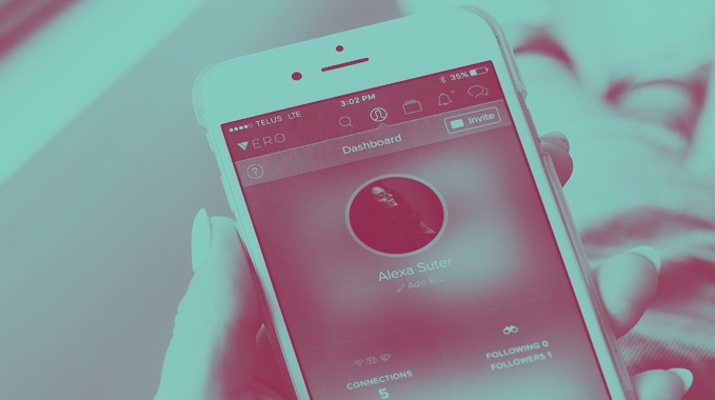
How People Use Social Media
Nearly all Americans use social media at least once per day. Social media is an important part of people's everyday lives, and people regularly access a variety of social media channels from mediums such as a mobile app or computer web browser, according to a survey of more than 600 social media users.
The average person will spend 5 years of his or her life on social media – more time than they will spend eating, socializing, and grooming. As people continue to spend more time on social media, that number will only increase.
Social media is an important part of people’s everyday lives.
The Manifest surveyed 627 social media users to learn about their social media habits: the channels they prefer, how frequently they use social media, and the mediums they use to access it.
People use a variety of social media channels, which tend to differ based on demographic factors such as gender.
Businesses can use this report to learn how customers use social media and how to appeal to them through social networking.
Our Findings
- Nearly everyone (86%) uses social media at least once per day, and 72% use it multiple times per day.
- Most people use Facebook (82%), YouTube (75%), and Instagram (53%) at least once per week.
- People use several social media channels more in 2018 than they did in 2017, including YouTube (63%), Instagram (61%), Snapchat (58%), and Facebook (52%).
- People use a combination of methods to access social media, including mobile apps (67%), computer web browsers (57%), mobile web browsers (41%), and tablet apps (31%).
- Nearly half of social media users (46%) prefer to access social media on mobile apps.
- Three-fourths of females (75%) use social media multiple times per day, compared to 64% of males.
- The majority of both females (83%) and males (81%) use Facebook at least once a week, but they vary in how they use other channels, including Pinterest, Twitter, and Reddit.
- Females are more likely to use mobile apps to access social media (52%), and males are more likely to prefer computer web browsers (33%).
Nearly Everyone Uses Social Media Daily
Social media is ingrained in people’s everyday lives; nearly all use it daily.
Eighty-six percent (86%) of people use social media at least once per day, including 72% who use it multiple times per day.

Social media is so popular because it allows people to manage and accomplish their everyday activities.
“Social media is a large part of everybody’s life,” said Josh Loewen, digital marketing director of The Status Bureau, a digital marketing agency in Vancouver. “It’s how people communicate, look for events, notice stores and brands, and find the weather. It’s how people are aided in their daily life.”
Social media is part of people’s routine and is an essential way to communicate, shop, find things to do, and check the news.
For some, regular social media use even opens up career opportunities. Blogger and influencer Christina Vidal turned sharing content with friends on social media into a career.
“I have always loved to travel and to give travel recommendations to my friends, so when social media took off, [it] became the perfect platform to share those travels with my friends, and then their friends and their friends-of-friends, and soon a whole audience of travel-lovers looking for their next big trip,” Vidal said.
Vidal uses social media multiple times per day and now has nearly 63,000 followers on her Instagram account, @jetsetchristina.

Vidal regularly posts images of her travels, which receive several thousand likes.
“I’m never not creating and sharing content of my travels,” Vidal said.
Social media is part of consumers’ everyday lives – and many people, like Vidal, rely on it.
People Use a Variety of Social Media Channels
People access multiple social media channels regularly.
Most use Facebook (82%), YouTube (75%), and Instagram (53%) at least once per week.
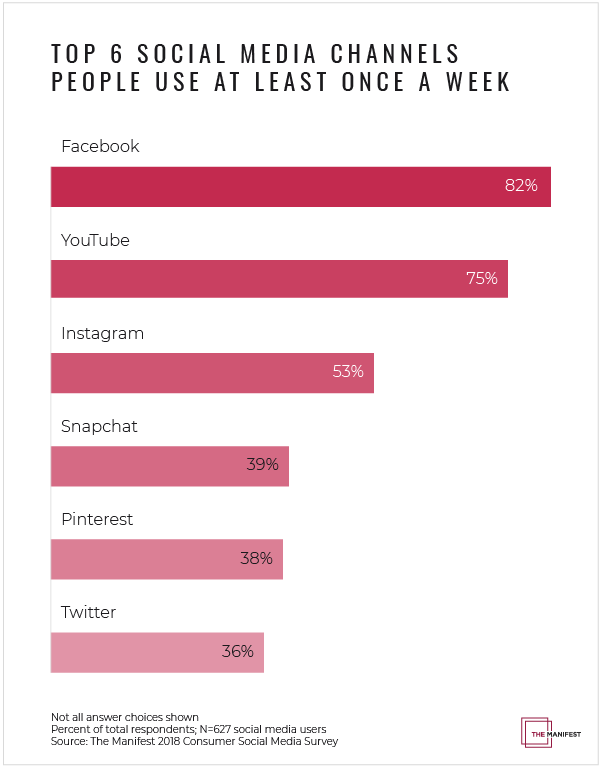
Other popular channels include Snapchat (39%), Pinterest (38%), and Twitter (36%).
Facebook is the most popular because it is among the oldest and most-established of the social media channels, so it has a larger user base.
“[Facebook] has been defaulted to people’s home on the internet; it’s the other internet,” Loewen said. “When people think of where to go and what media to consume, they go to Facebook. It’s like when you’re bored, you turn on the TV. Regardless of whether the channels on TV are bad or not, you’re going to turn on the TV. People are going to use Facebook.”
Facebook is the dominant social media channel. However, more than half of social media users also use YouTube and Instagram.
“Instagram and YouTube have very strong user bases,” said Charlotte Chipperfield, founder and CEO of Chipperfield Media. “People are using these channels for entertainment and learning whereas Facebook is a community-based platform to share life's big milestones with friends and family. Unlike Facebook, Instagram and YouTube serve as entertainment platforms first.”
Facebook provides a community space to make announcements and share with others. YouTube and Instagram are still popular, but they are mainly used for entertainment rather than sharing milestones or important news.
For example, Catherine Grace O’Connell uses a variety of channels, including YouTube, Pinterest, Twitter, and LinkedIn, but uses Facebook and Instagram the most frequently.
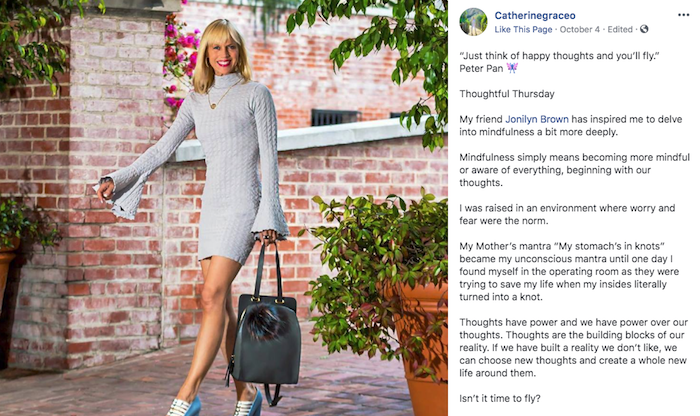
O’Connell became active on social media when she was diagnosed with Lyme Disease in 2014. She was bedridden and isolated and used social media as a way to communicate.
“I began reconnecting with the world and finding my voice,” O’Connell said. “Before I knew it, people were messaging me and asking for advice with their health issues.”
O’Connell’s community grew to more than 6,000 likes on Facebook and 44,000 followers on Instagram. She uses a variety of social channels to both share her story and listen to others.
“I found that discovering my voice was key to saving my life,” O’Connell said. "I’m not a techie but found social media to be literally life-changing for me and the thousands of women in my community.”
Using multiple social media channels – especially Facebook and Instagram – has helped O’Connell spread her message and inspire others.
People, whether they are influencers or regular social media users, use a variety of social media channels to reach their followers and share content.
People Use Social Media More in 2018 Than 2017
Most people use individual social media channels either more than or the same amount as they did in 2017.
More than half of social media users use YouTube (63%), Instagram (61%), Snapchat (58%), and Facebook (52%) more in 2018 compared to 2017.
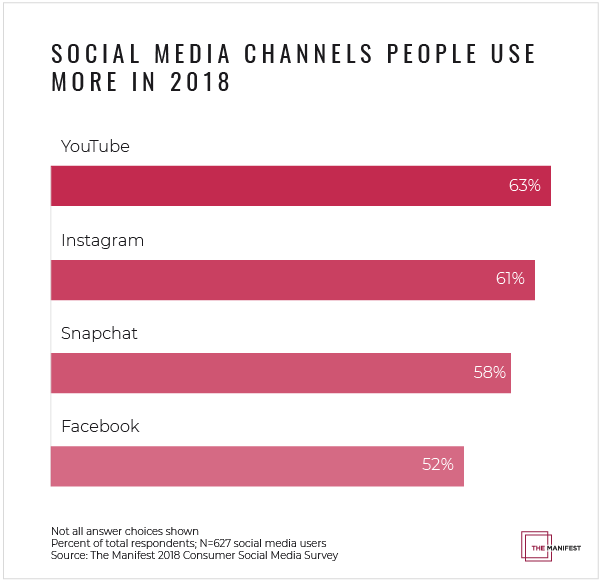
Less than 20% of people used Snapchat (15%), Facebook (15%), Instagram (9%), and YouTube (7%) more in 2017.
The number of people globally using social media grew by more than 100 million between January and March 2018, a number that is expected to continue increasing.
“Social media is increasingly ingrained in our day-to-day lives,” Chipperfield said. “It’s a way we communicate and share interests, and that’s only growing. People use social more and more every year.”
Social media has become an essential medium for socializing and sharing with others, and its usage will likely grow every year.
Users Access Social Media on Mobile Apps and Computer Web Browsers
People use a variety of methods to access social media, but most use mobile apps and computer web browsers.
Around two-thirds of people use mobile apps (67%) for social media, and more than half use computer web browsers (57%).

Mobile apps and computer web browsers are the most common methods to access social media because they are the two mediums consumers use the most in general – mobile phones on the go and computers at work. When people aren’t using one, they’re likely using the other.
“We have our phone on us at all times and our computer in front of us the other part of the time,” Loewen said. “They’re both really accessible mediums.”
People access social media at all times of the day – no matter if they’re on the go, at home, or at work.
People Prefer Mobile Apps for Social Media
Nearly half of social media users access social media the most frequently through mobile apps.
Forty-six percent (46%) of social media users prefer to use social media on mobile apps.

People use mobile apps the most because they have their smartphones on them at all times.
“We’re tied to our phones,” Chipperfield said. “It’s easy to check social media pretty quickly if you’re on a commute, on a train to work, on your lunch break, or walking into a meeting.”
People likely always have their smartphones with them, so it makes sense they use mobile apps to access social media the most.
Social media mobile apps are convenient for people like O’Connell, who have an active lifestyle.
“I feel as though I’m on the go a lot,” O’Connell said. “I like being very accessible.”
Mobile apps are easy for people to use no matter where they are or what they are doing.
Social Media Is the Modern Reprieve From Work
People who access social media on computer web browsers are likely doing so at work, which some believe causes employees to be less productive and waste work time.
More than half of businesses have a policy about social media usage at work. However, many use social media to take a mental break from work, which explains why 26% of social media users prefer to use social media on their computers.

Employees will take breaks from work, with or without social media.
“Prior to the widespread use of modern electronics, my employees would still find ways to break up the work day, including long coffee breaks or extended conversations with their coworkers,” said Rich Franklin, director of recruitment at KBC Staffing. “In today’s workplace, much of this interaction has been replaced by extended breaks on social media.”
Accessing social media at work is simply a modern way that employees take breaks.
“As a realist, I know that nobody is able to sit for 8 hours straight and pound away at their keyboard like a robot,” Franklin said. “So, whether it’s social media, texting, coffee breaks, or long lunches, I have always been fine with my employees taking reasonable breaks as long as they get their work done.”
Whether a company has a policy against social media or not, employees will still take breaks during the day – on social media or doing something else.
Active personal social media use can also help businesses’ social media strategies.
For example, Sally Compton, public relations coordinator at the Oregon Coast Aquarium, said her personal social media experience has helped her create successful social media content for the company.
Compton creates posts that are relevant to pop culture, such as the Presidential Alert text Americans received on Oct. 3.

Compton uses social media posts that are relevant to popular culture to promote the aquarium.
“Growing up using social media really helped me in terms of knowing what kind of content people like and seeing what kind of stuff goes viral,” Compton said. “If you’re never online on social media, you’re not really knowing current trends and what people are saying. It helps me make relevant content for the aquarium that is both educational and enjoyable.”
Compton’s work on Oregon Coast Aquarium’s social media has paid off: The aquarium recently won the Outstanding Oregon Social Media Program Award at Travel Oregon’s annual Travel & Tourism Industry Achievement Awards.
Businesses that give employees the freedom to use social media can help employees break up their days at work and are likely to have more success at social media themselves.
Females Use Social Media More Frequently Than Males
More females than males use social media daily.
Three-fourths of females (75%) use social media multiple times per day, compared to 64% of males.

Women likely use social media more than men because social media appeals to many of their interests.
“I think women tend to be more creative and more fashionable,” said Joseph Rothstein, account manager at Social Media 55. “They tend to look for the trends more than men. The amount of content out there on the internet and on social entertain women more than they would men.”
Much of the content on social media tends to be geared more toward women’s interests and hobbies.
Social Media Channel Usage Varies by Gender
The majority of both males and females use Facebook at least once a week, but there is a gender divide in regards to how they use other social media channels.
Males are more likely than females to use Twitter (51%) and Reddit (29%) once per week, while females are more likely than males to use Pinterest (44%).
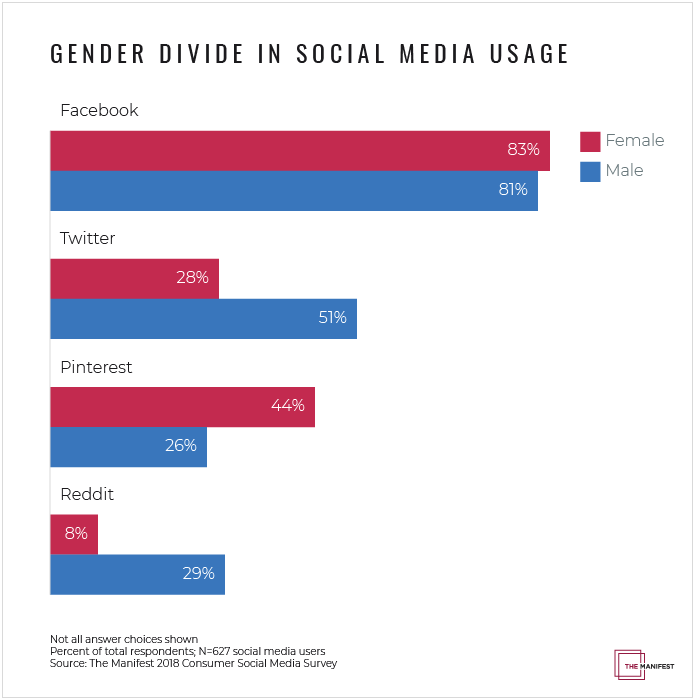
Women use Pinterest because its content focuses on topics such as food, design, and aesthetics, which traditionally appeal more to females.
“Women are more likely to use Pinterest because they are creating larger images for what they want their homes, weddings, and next birthday bashes to look like,” Chipperfield said. “Men might be thinking about it but not necessarily building out public boards to share with their friends and party planners.”
Women enjoy Pinterest because its content appeals to their interests, while men like Reddit and Twitter, which better match their communication styles.
“With platforms like Reddit and Twitter, imagery is secondary or non-existent,” Chipperfield said. “In my experience, men tend to prefer communicating through word-driven platforms where thoughts can be published quickly and don’t require crafting an image to accompany it.”
Men tend to prefer content with words, while women prefer content with visuals, which explains their preferred social media channels.
Females More Likely to Use Mobile Apps to Access Social Media
More women use social media mobile apps than men, while men use computer web browsers.
Females (52%) most frequently use mobile apps to access social media compared to males (34%).

Women use social media on their mobile apps because they traditionally have more mobile lifestyles – women typically install 40% more apps than men.
On the other hand, males (33%) are more likely to access social media on computer web browsers than females (21%).
Men tend to use computers more often than females, which explains why they are more likely to access social media from computer web browsers.
Women tend to download more mobile apps than men, while men tend to use computers more often than women, habits that extend to their social media use.
Social Media Can Help Businesses Appeal to Consumers
Most Americans have added social media to their daily routine; just like brushing their teeth, grooming, eating meals, and going to work or school, social media is an important part of people’s everyday lives.
People use social media every day, mainly with a mobile app or desktop computer. They use a variety of channels, including Facebook, YouTube, and Instagram, and their use of these channels has increased over the past year.
As people continue to rely on social media, it is important for businesses to understand their target customers’ social media habits and preferences to determine how to best reach and appeal to them.
Most consumers don’t go a single day without social media; businesses should be on it, too.
About the Survey
The Manifest surveyed 627 consumers from across the U.S. who have used social media in the past week.
Sixty-five percent (65%) of survey respondents are female; 35% are male.
About 14% of respondents are Generation Z (ages 13-17), 36% are millennials (ages 18-34), 31% are Generation X (ages 35-54), and 19% are baby boomers or older (ages 55+).
Most survey respondents are employed either full-time (42%) or part-time (16%). Others are homemakers (13%), retired (13%), students (12%), self-employed (5%), unemployed and currently looking for work (6%), or unemployed and not currently looking for work (6%).
Survey respondents’ education levels are 8th grade or lower (3%), some high school (14%), high school graduate or equivalent (24%), some college credit, no degree (26%), associate’s degree (13%), bachelor’s degree (21%), and master’s degree or higher (12%).
Respondents are from the South (39%), Midwest (23%), Northeast (20%), and West (17%).

